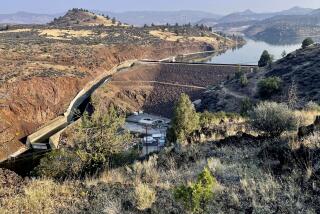Report Lists Findings at Chumash Site in Road’s Way : Highway: The Santa Rosa Valley project, resumed in March, will continue under the watchful eye of a Native American consultant.
- Share via
Archeologists unearthed 11 human bone fragments and three human teeth at a site believed to have been a Chumash village now in the path of a major thoroughfare in the Santa Rosa Valley, a final county report reveals.
The report, which was presented in summary to the Ventura County Board of Supervisors on Tuesday, also details findings of Chumash cooking implements and bones of deer, birds, coyote, turtles, rodents, fish and abalone.
But the archeologist’s final inventory of excavations at the site of widening and realigning of Santa Rosa Road lists no evidence of other remains. Evidence of a human burial was found last December when workers uncovered an urn possibly used in Chumash cremations. The discovery halted work on the project.
The site at one time may have been a large village, but the original road work 60 years ago and looters around that time make it unlikely that more artifacts or bones will be found, the summary report said.
“I just hope we don’t find anything else of significance out there,” said W. Butch Britt, deputy director of the county Public Works Department.
Work resumed in March, and on Tuesday road crews began paving a detour to allow completion of the final one-mile segment of the five-mile project. Work is expected to be complete next spring.
The report was developed during a six-month delay in the project that cost the county about $100,000, officials estimate. Costs were incurred from contract change orders, staff time, a Native American observer and archeological fees.
Supervisor Maggie Kildee said the report indicates that the county was thorough in protecting the Native American artifacts and remains.
“I hope they are satisfied,” she said of the Chumash descendants.
The county has taken the correct measures so far, said Cote Lotah, owner of Owl Clan Consultants, which monitored the excavations for the Native American community.
“We won’t feel really comfortable until they are off the site,” he said. “These sites are non-renewable resources and should be considered national treasures.”
*
Although Britt said that scientists did not speculate on how many people used the site, Lotah said it could have been a village of up to 1,000 people.
“It was a major trade center,” he said. “And it’s still extremely important because a large majority of the area is still intact.”
The scientist’s report is sealed at county offices to prevent looting of artifacts or Chumash remains at the site. Supervisors and the public were presented with an annotated version prepared by county staff.
Lotah said that even without revealing the exact location of the Chumash site, there are scavengers looking for artifacts because of the prices they bring in the art market.
“What they find out there today will be for sale in a Santa Fe art gallery tomorrow,” he said.
Some suspected looters have been seen driving around near the area with tools in their cars, Britt said, but there have been no arrests.
The $5.5-million project that began in 1990 was designed to eliminate curves and hills that impair vision along the road, which is now used by about 11,000 vehicles a day.
Work was first delayed when the urn was discovered during grading to realign the road.
Archeologists were hired to investigate the site and a Native American consultant was employed to observe any excavation or grading work. Lotah’s firm will continue monitoring the project until it is finished.
More to Read
Sign up for Essential California
The most important California stories and recommendations in your inbox every morning.
You may occasionally receive promotional content from the Los Angeles Times.













